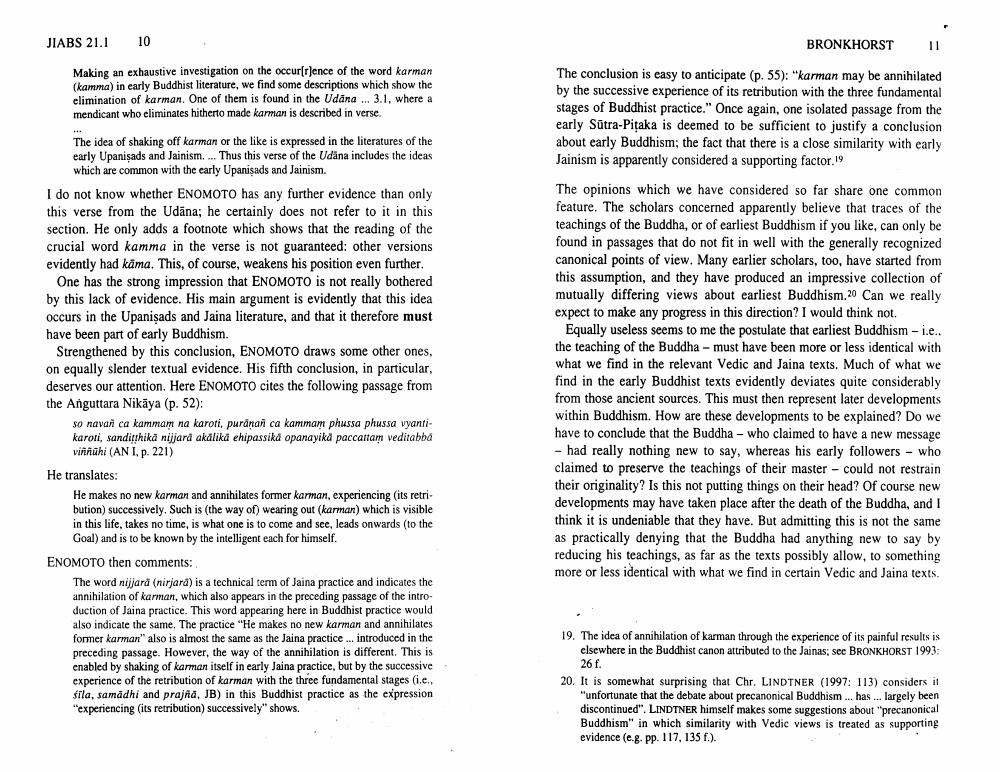Book Title: Did Buddha Believe In Karma And Rebirth Author(s): Johannes Bronkhorst Publisher: Johannes Bronkhorst View full book textPage 6
________________ JIABS 21.1 10 Making an exhaustive investigation on the occur[r]ence of the word karman (kamma) in early Buddhist literature, we find some descriptions which show the elimination of karman. One of them is found in the Udana... 3.1, where a mendicant who eliminates hitherto made karman is described in verse. The idea of shaking off karman or the like is expressed in the literatures of the early Upanisads and Jainism.... Thus this verse of the Udana includes the ideas which are common with the early Upanisads and Jainism. I do not know whether ENOMOTO has any further evidence than only this verse from the Udana; he certainly does not refer to it in this section. He only adds a footnote which shows that the reading of the crucial word kamma in the verse is not guaranteed: other versions evidently had kama. This, of course, weakens his position even further. One has the strong impression that ENOMOTO is not really bothered by this lack of evidence. His main argument is evidently that this idea occurs in the Upaniṣads and Jaina literature, and that it therefore must have been part of early Buddhism. Strengthened by this conclusion, ENOMOTO draws some other ones, on equally slender textual evidence. His fifth conclusion, in particular, deserves our attention. Here ENOMOTO cites the following passage from the Anguttara Nikaya (p. 52): so navañ ca kammam na karoti, puraṇan ca kammam phussa phussa vyantikaroti, sanditthikā nijjarā akālikā ehipassikä opanayikä paccattam veditabba vinnuhi (AN I, p. 221) He translates: He makes no new karman and annihilates former karman, experiencing (its retribution) successively. Such is (the way of) wearing out (karman) which is visible in this life, takes no time, is what one is to come and see, leads onwards (to the Goal) and is to be known by the intelligent each for himself. ENOMOTO then comments: The word nijjară (nirjara) is a technical term of Jaina practice and indicates the annihilation of karman, which also appears in the preceding passage of the introduction of Jaina practice. This word appearing here in Buddhist practice would also indicate the same. The practice "He makes no new karman and annihilates former karman" also is almost the same as the Jaina practice... introduced in the preceding passage. However, the way of the annihilation is different. This is enabled by shaking of karman itself in early Jaina practice, but by the successive experience of the retribution of karman with the three fundamental stages (i.e.. sila, samadhi and prajñā, JB) in this Buddhist practice as the expression "experiencing (its retribution) successively" shows. BRONKHORST The conclusion is easy to anticipate (p. 55): "karman may be annihilated by the successive experience of its retribution with the three fundamental stages of Buddhist practice." Once again, one isolated passage from the early Sūtra-Pitaka is deemed to be sufficient to justify a conclusion about early Buddhism; the fact that there is a close similarity with early Jainism is apparently considered a supporting factor. 19 The opinions which we have considered so far share one common feature. The scholars concerned apparently believe that traces of the teachings of the Buddha, or of earliest Buddhism if you like, can only be found in passages that do not fit in well with the generally recognized canonical points of view. Many earlier scholars, too, have started from this assumption, and they have produced an impressive collection of mutually differing views about earliest Buddhism.20 Can we really expect to make any progress in this direction? I would think not. Equally useless seems to me the postulate that earliest Buddhism - i..... the teaching of the Buddha - must have been more or less identical with what we find in the relevant Vedic and Jaina texts. Much of what we find in the early Buddhist texts evidently deviates quite considerably from those ancient sources. This must then represent later developments within Buddhism. How are these developments to be explained? Do we have to conclude that the Buddha- who claimed to have a new message - had really nothing new to say, whereas his early followers - who claimed to preserve the teachings of their master could not restrain their originality? Is this not putting things on their head? Of course new developments may have taken place after the death of the Buddha, and I think it is undeniable that they have. But admitting this is not the same as practically denying that the Buddha had anything new to say by reducing his teachings, as far as the texts possibly allow, to something more or less identical with what we find in certain Vedic and Jaina texts. 19. The idea of annihilation of karman through the experience of its painful results is elsewhere in the Buddhist canon attributed to the Jainas; see BRONKHORST 1993: 26 f. 20. It is somewhat surprising that Chr. LINDTNER (1997: 113) considers it "unfortunate that the debate about precanonical Buddhism... has ... largely been discontinued". LINDTNER himself makes some suggestions about "precanonical Buddhism" in which similarity with Vedic views is treated as supporting evidence (e.g. pp. 117, 135 f.).Page Navigation
1 ... 4 5 6 7 8 9 10
